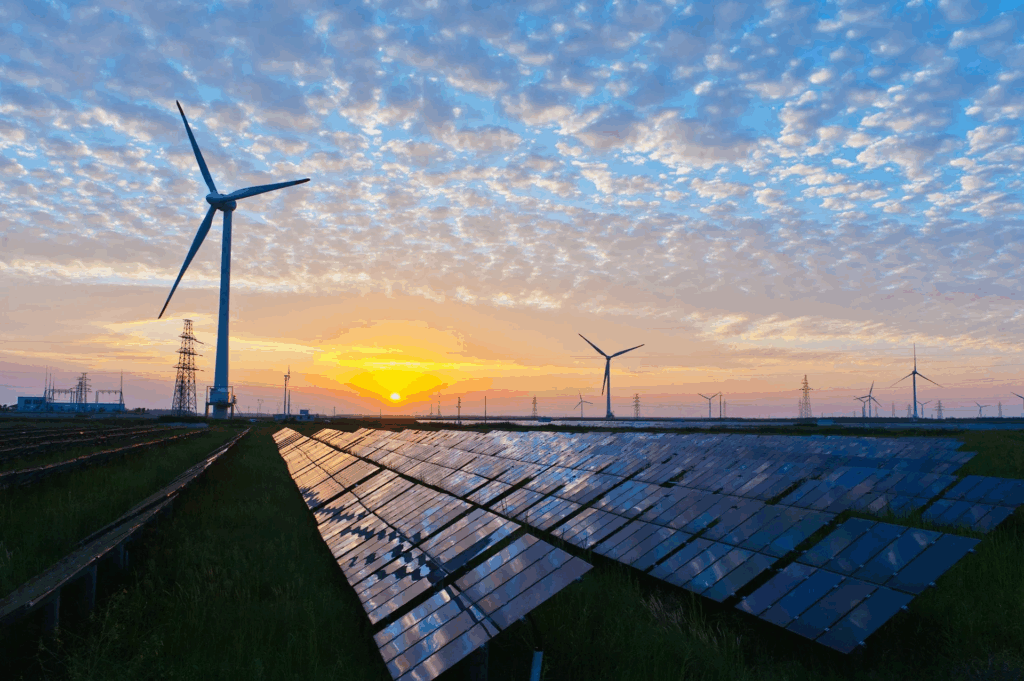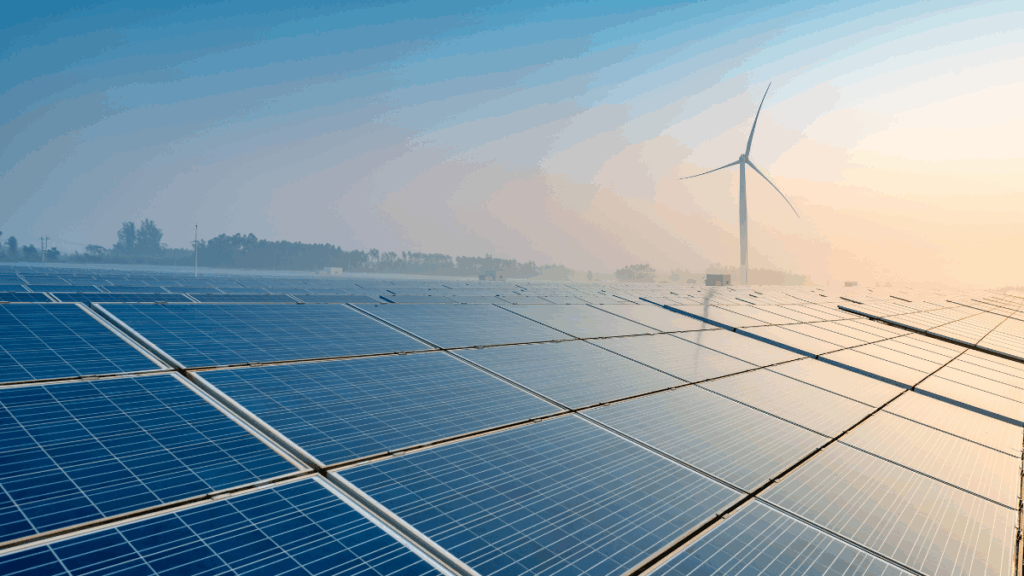Large-scale solar installations have long been heralded as a cornerstone of the global transition to renewable energy, primarily due to their ability to generate clean electricity and reduce carbon emissions. However, groundbreaking research emerging from China’s Talatan Desert reveals an unexpected co-benefit of these sprawling facilities: they may also play a pivotal role in revitalizing fragile desert ecosystems. This discovery challenges conventional perceptions of solar farms as purely industrial projects and positions them as potential tools for ecological restoration.
A recent study conducted by researchers from Xi’an University of Technology, Hokkaido University, and AZUL Energy, Inc., focused on the ecological impact of the one-gigawatt Gonghe Photovoltaic Park in Qinghai Province. Using the comprehensive DPSIR (Driving forces, Pressures, State, Impact, Responses) model, the team meticulously analyzed 57 environmental indicators, including soil composition, temperature, humidity, biodiversity, and vegetation growth. The findings were nothing short of remarkable.
Revolutionary Findings: Solar Panels as Catalysts for Ecological Recovery
The results of the study revealed a dramatic improvement in the ecological health of areas directly beneath the solar panels compared to surrounding regions. Areas under the panels demonstrated significantly improved ecological health scores (0.4393), while transitional zones bordering the park scored slightly lower (0.2858). Untouched desert areas farthest from the solar farm had the lowest score (0.2802), highlighting the stark contrast between the park’s influence and the barren conditions of the natural desert.
This transformation was not merely incremental but represented a fundamental shift in the local environment. Researchers identified several key factors driving this change:
- Microclimate Creation: The vast arrays of solar panels provide consistent shade, drastically reducing ground temperatures and limiting water evaporation from the soil surface. This retained moisture, combined with cooler conditions, creates a micro-environment far more hospitable than the surrounding exposed desert.
- Enhanced Soil Quality: The shaded areas beneath the panels foster increased microbial activity within the soil, improving nutrient content and fertility. This, in turn, supports the growth of vegetation where little to none existed before.
- Vegetation Growth: The improved microclimate encourages the germination and growth of plants, creating pockets of greenery in an otherwise arid landscape. These plants further stabilize the soil, prevent erosion, and support small-scale ecosystems.
In essence, the solar farm acts as an unintentional nursery, kickstarting a process of ecological recovery on previously degraded or barren land. This dual benefit—generating clean energy while fostering ecosystem revival—represents a paradigm shift in how we view large-scale renewable energy projects.

Benchmarking a New Approach to Sustainable Development
This study provides a vital benchmark against traditional views, where large infrastructure projects are often assessed primarily for their potential negative environmental impacts. Here, we see evidence of significant positive ecological externalities. It suggests a new benchmark solution for sustainable development: designing and deploying renewable energy projects not just to minimize harm, but potentially to actively contribute to environmental restoration.
The key “solutions” highlighted by this benchmark finding include:
- Strategic Site Selection:
The positive results underscore the critical importance of choosing appropriate locations for solar farms. While solar irradiation is a primary consideration, planners should also evaluate the potential for ecological co-benefits in degraded areas such as deserts or abandoned agricultural lands. This approach aligns with broader goals of land rehabilitation and climate adaptation. - Eco-Conscious Design:
While not explicitly detailed in the summary, the findings open the door to exploring designs that could further enhance these positive ecological effects. For example:- Adjusting panel spacing and height to optimize shading and airflow.
- Incorporating native vegetation planting schemes around the perimeter of the solar farm.
- Implementing water retention systems to maximize moisture availability.
- Integrated Planning:
Future energy projects could integrate ecological restoration goals from the outset, viewing the solar farm as a dual-purpose installation. Governments and private developers could collaborate to ensure that renewable energy projects align with national biodiversity and conservation targets.
By benchmarking these solutions, we can create a replicable framework for other countries to follow, particularly those with vast arid regions like Australia, the Middle East, and parts of Africa.
Caution and Future Directions
While the findings are incredibly promising, the researchers emphasize the need for caution and further investigation. Long-term monitoring is crucial to fully understand the lasting effects on local biodiversity, complex water cycles, and regional climate patterns. Several questions remain unanswered:
- Will the initial vegetation growth lead to diverse, resilient ecosystems, or will it be dominated by invasive species?
- How do these changes interact with larger environmental systems, such as regional rainfall patterns and groundwater levels?
- Can similar benefits be replicated in other types of degraded landscapes, such as coastal deserts or deforested areas?
These questions require ongoing study and collaboration between ecologists, engineers, and policymakers. Additionally, careful site selection remains essential. Not all deserts are alike, and poorly planned solar farms could exacerbate existing environmental issues, such as habitat fragmentation or water scarcity.

A Blueprint for Holistic Sustainable Development
This research redefines the narrative around large-scale solar power. It presents compelling evidence that generating clean energy and restoring ecosystems need not be separate goals. By carefully planning and siting solar farms, particularly in arid and degraded regions, we may unlock a powerful dual strategy—tackling climate change through renewable energy while simultaneously breathing life back into the land.
Imagine solar farms doubling as nature reserves, where endangered species find refuge amidst rows of photovoltaic panels. Or envision desert communities benefiting from restored grazing lands and improved air quality thanks to thriving vegetation. These possibilities highlight the transformative potential of integrating renewable energy with ecological restoration.
Moreover, this approach offers a potential blueprint for more holistic and effective sustainable development worldwide. Countries grappling with both energy deficits and environmental degradation can adopt this dual-purpose model, leveraging renewable energy projects to achieve multiple objectives simultaneously.
Global Implications and Opportunities
The implications of this study extend far beyond China’s borders. As nations strive to meet ambitious renewable energy targets, they must also address the pressing issue of land degradation. According to the United Nations Convention to Combat Desertification (UNCCD), up to 40% of the world’s land is degraded, affecting over 3 billion people globally. Large-scale solar farms could serve as a practical solution to combat desertification while advancing clean energy goals.
For instance:
- In sub-Saharan Africa, solar farms could help reclaim degraded farmland and improve food security.
- In the Middle East, they could combat desertification and support reforestation efforts.
- In Australia, they could aid in conserving biodiversity in arid regions.
By adopting the benchmark solutions outlined in this study, governments and private developers can ensure that renewable energy projects deliver maximum value—not just in terms of energy production but also in terms of environmental and social benefits.
Conclusion: A Vision for the Future
The discovery that solar farms can transform deserts into thriving ecosystems represents a monumental leap forward in our understanding of sustainable development. It demonstrates that humanity’s quest for clean energy does not have to come at the expense of the environment; rather, it can complement and even enhance ecological health.
As the world continues to pursue innovative solutions to combat climate change and environmental degradation, studies like this remind us of the untapped potential of integrated approaches. By viewing solar farms as multifunctional assets, we can create a future where clean energy and ecological restoration go hand in hand—a future where technology and nature work together to heal the planet.
Related Videos
Related Content
- The Positive and Negative Environmental Impacts of Solar Panels – Kuby
- Revolutionizing Renewable Energy with Perovskite-CIGS Tandem Solar Cells
- Biophotovoltaic Systems: The Next Evolution in Solar Energy
- Mercedes-Benz Revolutionizes Electric Vehicles with Solar Paint
- Space-Based Solar Power: A Revolutionary Leap in Energy Production
- A Comprehensive Look at Two Innovative Renewable Energy Projects: Solar Highways and the Western Green Energy Hub
- MIT Develops Battery-Free Solar Desalination System: A Game-Changer for Clean Water Access
- Chinese green technologies are pouring into Latin America
- Why wind and solar are key solutions to combat climate change | Ember
- Solar – IEA
- Why solar and storage will drive the clean energy transition | World Economic Forum
- Renewables – Energy System – IEA
